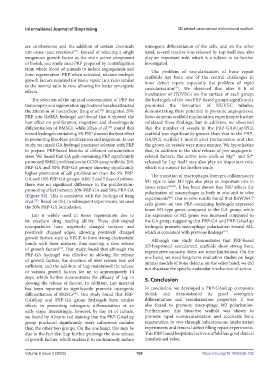Page 204 - IJB-9-3
P. 204
International Journal of Bioprinting 3D-printed vascularized biofunctional scaffold
are cumbersome and the addition of certain chemicals osteogenic differentiation of the cells, and on the other
can cause toxic reactions . Instead of selecting a single hand, several reactive ions released by Lap itself may also
[37]
exogenous growth factor as the main active component play an important role, which is a subject to be further
of bioink, our study used PRP prepared by centrifugation investigated.
from whole blood of animals to induce angiogenesis and The problem of vascularization of bone repair
bone regeneration. PRP, when activated, releases multiple scaffolds has been one of the central challenges in
growth factors required for tissue repair in a ratio similar bone defect repair, especially the problem of rapid
to the normal ratio in vivo, allowing for better synergistic vascularization [41] . We observed that after 6 h of
effects. incubation of HUVECs on the surface of each group,
The selection of the optimal concentration of PRP for the hydrogels of the two PRP-based groups significantly
tissue repair and regeneration applications has also attracted promoted the formation of HUVEC tubules,
the attention of researchers. Jiang et al. integrated 20% demonstrating their potential to promote angiogenesis.
[38]
PRP into GelMA hydrogel and found that it showed the Subcutaneous scaffold implantation experiments further
best effect on proliferation, migration and chondrogenic validated these findings, but in addition, we observed
differentiation of BMSCs, while Zhao et al. found that that the number of vessels in the PRP-GA@Lap/PCL
[39]
mixed hydrogels containing 5% PRP showed the best effect scaffold was significantly greater than that in the PRP-
in promoting fibroblast proliferation and migration. In our GA/PCL scaffold 1 month after implantation and that
study, we mixed GA hydrogel precursor solution with PRP the grown-in vessels were more mature. We hypothesize
to prepare PRP-based bioinks of different concentration that, in addition to the slow release of pro-angiogenic-
sizes. We found that GA gels containing PRP significantly related factors, the active ions such as Mg and Si
2+
4+
promoted BMSC proliferation by CCK8 assay, with the 20% released by Lap itself may also play an important role,
PRP-GA and 50% PRP-GA groups showing significantly which is a subject for further study.
higher promotion of cell proliferation than the 5% PRP- The transition of macrophages from pro-inflammatory
GA and 10% PRP-GA groups. After 3 and 5 days of culture, M1 type to later M2 type also plays an important role in
there was no significant difference in the proliferation- tissue repair [42,43] . It has been shown that PRP affects the
promoting effect between 20% PRP-GA and 50% PRP-GA polarization of macrophages in both in vivo and in vitro
(Figure S2). This is consistent with the findings of Jiang experiments . Our in vitro results found that RAW264.7
[44]
et al. . Based on this, in subsequent experiments, we used cells grown on two PRP-containing hydrogels expressed
[38]
the 20% PRP-GA formulation.
fewer M1-type genes compared to the GA group, while
Lap is widely used in tissue regeneration due to the expression of M2 genes was increased compared to
its excellent drug loading ability. These disk-shaped the GA group, suggesting that PRP-GA and PRP-GA@Lap
nanoparticles have negatively charged surfaces and hydrogels promote macrophage polarization toward M2,
positively charged edges, allowing positively charged which is consistent with previous findings .
[44]
growth factors, such as VEGF, to form strong electrostatic Although our study demonstrates that PRP-based
bonds with their surfaces, thus exerting a slow release 3D-bioprinted vascularized scaffolds show strong bone
of growth factors . Our study found that although the regenerative capacity, there are some limitations. On the
[25]
PRP-GA hydrogel was effective in slowing the release one hand, we need long-term evaluation studies on large
of growth factors, the duration of slow release was not animal models of bone defects; on the other hand, we did
sufficient, and the addition of Lap maintained the release not elucidate the specific molecular mechanism of action.
of various growth factors for up to approximately 14
days, which further demonstrates the efficacy of Lap in 5. Conclusion
slowing the release of factors. In addition, Lap material
has been reported to significantly promote osteogenic In conclusion, we developed a PRP-GA@Lap composite
differentiation of BMSCs . Our study found that PRP- bioink and demonstrated its good osteogenic
[40]
GA@Lap and PRP-GA group hydrogels have similar differentiation and vascularization properties. It was
effects in promoting osteogenic differentiation at an also found to promote macrophage M2 polarization.
early stage. Interestingly, however, by day 14 of culture, Furthermore, this bioactive scaffold was shown to
we found by Alizarin red staining that the PRP-GA@Lap promote rapid neovascularization and accelerate bone
group produced significantly more calcareous nodules regeneration in vivo through subcutaneous implantation
than the other two groups. On the one hand, this may be experiments and femoral defect filling repair experiments.
due to the fact that Lap further prolongs the slow release This PRP-based bioprinted active scaffold has great clinical
of growth factors, which enables it to continuously induce translational value.
Volume 9 Issue 3 (2023) 196 https://doi.org/10.18063/ijb.702

